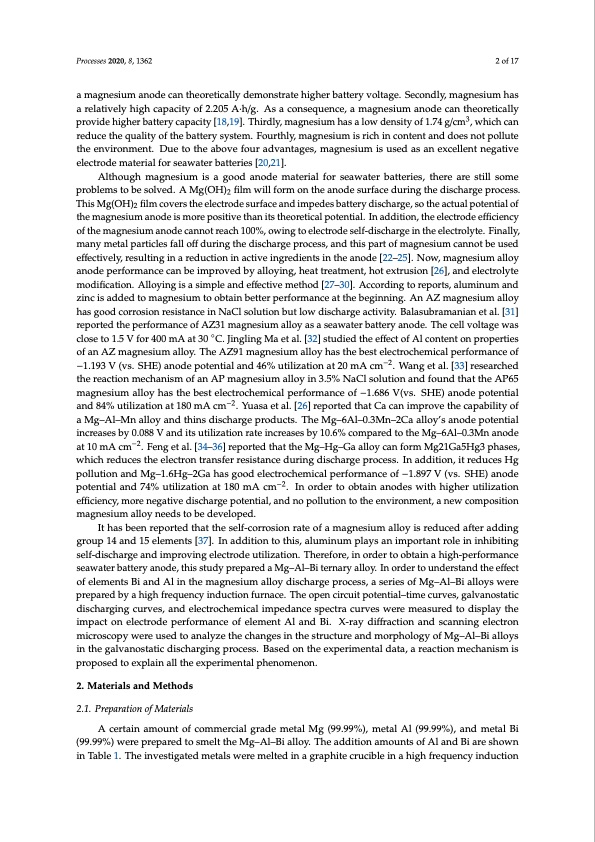
PDF Publication Title:
Text from PDF Page: 002
Processes 2020, 8, 1362 2 of 17 a magnesium anode can theoretically demonstrate higher battery voltage. Secondly, magnesium has a relatively high capacity of 2.205 A·h/g. As a consequence, a magnesium anode can theoretically provide higher battery capacity [18,19]. Thirdly, magnesium has a low density of 1.74 g/cm3, which can reduce the quality of the battery system. Fourthly, magnesium is rich in content and does not pollute the environment. Due to the above four advantages, magnesium is used as an excellent negative electrode material for seawater batteries [20,21]. Although magnesium is a good anode material for seawater batteries, there are still some problems to be solved. A Mg(OH)2 film will form on the anode surface during the discharge process. This Mg(OH)2 film covers the electrode surface and impedes battery discharge, so the actual potential of the magnesium anode is more positive than its theoretical potential. In addition, the electrode efficiency of the magnesium anode cannot reach 100%, owing to electrode self-discharge in the electrolyte. Finally, many metal particles fall off during the discharge process, and this part of magnesium cannot be used effectively, resulting in a reduction in active ingredients in the anode [22–25]. Now, magnesium alloy anode performance can be improved by alloying, heat treatment, hot extrusion [26], and electrolyte modification. Alloying is a simple and effective method [27–30]. According to reports, aluminum and zinc is added to magnesium to obtain better performance at the beginning. An AZ magnesium alloy has good corrosion resistance in NaCl solution but low discharge activity. Balasubramanian et al. [31] reported the performance of AZ31 magnesium alloy as a seawater battery anode. The cell voltage was close to 1.5 V for 400 mA at 30 ◦C. Jingling Ma et al. [32] studied the effect of Al content on properties of an AZ magnesium alloy. The AZ91 magnesium alloy has the best electrochemical performance of −1.193 V (vs. SHE) anode potential and 46% utilization at 20 mA cm−2. Wang et al. [33] researched the reaction mechanism of an AP magnesium alloy in 3.5% NaCl solution and found that the AP65 magnesium alloy has the best electrochemical performance of −1.686 V(vs. SHE) anode potential and 84% utilization at 180 mA cm−2. Yuasa et al. [26] reported that Ca can improve the capability of a Mg–Al–Mn alloy and thins discharge products. The Mg–6Al–0.3Mn–2Ca alloy’s anode potential increases by 0.088 V and its utilization rate increases by 10.6% compared to the Mg–6Al–0.3Mn anode at 10 mA cm−2. Feng et al. [34–36] reported that the Mg–Hg–Ga alloy can form Mg21Ga5Hg3 phases, which reduces the electron transfer resistance during discharge process. In addition, it reduces Hg pollution and Mg–1.6Hg–2Ga has good electrochemical performance of −1.897 V (vs. SHE) anode potential and 74% utilization at 180 mA cm−2. In order to obtain anodes with higher utilization efficiency, more negative discharge potential, and no pollution to the environment, a new composition magnesium alloy needs to be developed. It has been reported that the self-corrosion rate of a magnesium alloy is reduced after adding group 14 and 15 elements [37]. In addition to this, aluminum plays an important role in inhibiting self-discharge and improving electrode utilization. Therefore, in order to obtain a high-performance seawater battery anode, this study prepared a Mg–Al–Bi ternary alloy. In order to understand the effect of elements Bi and Al in the magnesium alloy discharge process, a series of Mg–Al–Bi alloys were prepared by a high frequency induction furnace. The open circuit potential–time curves, galvanostatic discharging curves, and electrochemical impedance spectra curves were measured to display the impact on electrode performance of element Al and Bi. X-ray diffraction and scanning electron microscopy were used to analyze the changes in the structure and morphology of Mg–Al–Bi alloys in the galvanostatic discharging process. Based on the experimental data, a reaction mechanism is proposed to explain all the experimental phenomenon. 2. Materials and Methods 2.1. Preparation of Materials A certain amount of commercial grade metal Mg (99.99%), metal Al (99.99%), and metal Bi (99.99%) were prepared to smelt the Mg–Al–Bi alloy. The addition amounts of Al and Bi are shown in Table 1. The investigated metals were melted in a graphite crucible in a high frequency inductionPDF Image | Alloy Anode for Seawater Batteries and Related Mechanisms

PDF Search Title:
Alloy Anode for Seawater Batteries and Related MechanismsOriginal File Name Searched:
processes-08-01362.pdfDIY PDF Search: Google It | Yahoo | Bing
Product and Development Focus for Salgenx
Redox Flow Battery Technology: With the advent of the new USA tax credits for producing and selling batteries ($35/kW) we are focussing on a simple flow battery using shipping containers as the modular electrolyte storage units with tax credits up to $140,000 per system. Our main focus is on the salt battery. This battery can be used for both thermal and electrical storage applications. We call it the Cogeneration Battery or Cogen Battery. One project is converting salt (brine) based water conditioners to simultaneously produce power. In addition, there are many opportunities to extract Lithium from brine (salt lakes, groundwater, and producer water).Salt water or brine are huge sources for lithium. Most of the worlds lithium is acquired from a brine source. It's even in seawater in a low concentration. Brine is also a byproduct of huge powerplants, which can now use that as an electrolyte and a huge flow battery (which allows storage at the source).We welcome any business and equipment inquiries, as well as licensing our flow battery manufacturing.| CONTACT TEL: 608-238-6001 Email: greg@salgenx.com | RSS | AMP |